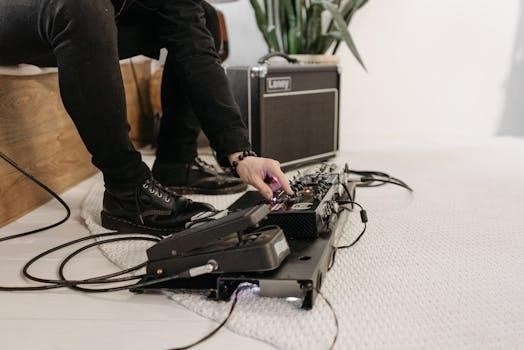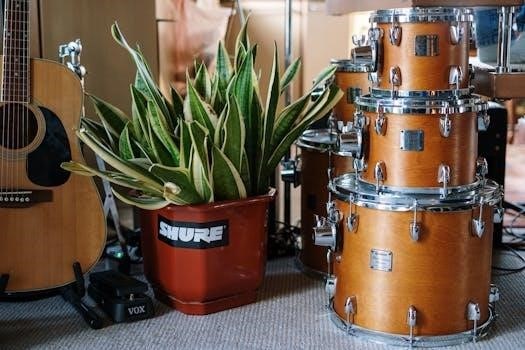guitar caged system pdf
The CAGED system is a method for understanding the guitar fretboard. It uses five basic open chord shapes⁚ C, A, G, E, and D. These shapes allow you to play chords, scales, and arpeggios all over the neck. The system also helps you connect chords and improvise.
What is the CAGED System?
The CAGED system is a powerful tool for guitarists, providing a framework for understanding the entire fretboard. It’s based on five fundamental open chord shapes⁚ C, A, G, E, and D. These shapes aren’t just about playing those specific chords; they are templates that can be moved up and down the neck to create different chords in various keys. The beauty of the CAGED system lies in its ability to connect these shapes, allowing for smooth transitions between chords and positions. It’s a visual and logical method that helps guitarists see the patterns and relationships between notes, chords, scales, and arpeggios. By mastering these five shapes, you can unlock a deeper understanding of the guitar and enhance your playing in many ways. It’s a system that encourages you to think of the fretboard as a series of interconnected shapes, rather than isolated positions. This is not only for major chords, but the shapes can also be used for minor chords and more advanced concepts.

Understanding the Five Core Shapes
The CAGED system revolves around five essential shapes; Each shape corresponds to an open chord⁚ C, A, G, E, and D. These shapes can be moved around the fretboard. Understanding them is crucial for navigating the guitar neck.
The C Shape
The C shape is one of the foundational shapes in the CAGED system. It’s derived from the open C major chord, a common starting point for many guitarists. This shape can be moved up the fretboard to create other major chords by using barre chords. The root note of the C shape is on the fifth string, and this root can be used to find chords all over the guitar neck. The C shape is very versatile for chord voicings and is also used to find scale patterns and arpeggios. It can be used to play major, minor, and dominant chords and more. Understanding the C shape’s structure allows guitarists to build chords, scales and arpeggios on the fly. The shape is easy to visualise, which makes it a good way to start learning the CAGED system. It is also a good framework for learning triads. This shape is a crucial building block for guitarists of all levels. This form’s root note is on the fifth string.
The A Shape
The A shape is another crucial component of the CAGED system; It is derived from the open A major chord shape, and it’s a foundational pattern for playing barre chords. The root note of the A shape is on the fifth string, making it easy to locate and move up the fretboard. This shape is used to play different major chords by using barre chords. This versatile shape can also be used to build minor chords and dominant chords. It is also used for finding arpeggios and scales. Understanding this shape allows you to visualise the fretboard in a new way. The A shape is a critical component of understanding how chords connect on the neck. It is an essential tool for both beginners and advanced players. The root is on the fifth string. It also provides a solid starting point for exploring other musical ideas; This shape is very useful for connecting chords.
The G Shape
The G shape, based on the open G major chord, provides another essential pattern within the CAGED system. The root note for the G shape is located on the sixth string. This shape is also used for creating barre chords. This shape also allows for the creation of minor and dominant chords. Understanding the G shape helps you to see the fretboard as a series of interconnected patterns. This makes it easier to navigate and improvise. The G shape is also useful for arpeggios. The shape also facilitates moving up and down the guitar neck. The G shape is a great way to connect chords, scales and arpeggios. This shape, like the others, provides a framework for understanding how chords relate to each other. It is an invaluable asset for guitarists at all levels. The root is on the sixth string.
The E Shape
The E shape is derived from the open E major chord. This is one of the most common shapes. The root note of this shape is located on the sixth string. This shape is used extensively for playing barre chords across the guitar neck. The E shape provides a solid foundation for building minor and dominant chords. Understanding the E shape enhances your ability to navigate the fretboard. This shape also allows you to find the notes and intervals within a scale or arpeggio. This shape is one of the most versatile. The E shape helps you move around the fretboard. This is very useful for improvising. Recognizing the E shape in different positions gives you a visual map of the neck. This improves your overall playing experience. It’s a fundamental building block. The root is on the sixth string.
The D Shape
The D shape is based on the open D major chord. It is another crucial shape in the CAGED system. The root note of this shape is located on the fourth string. The D shape is also used for playing barre chords. This shape also works well for playing minor and dominant chords by adjusting the finger positions. The D shape provides a different fingering approach compared to the other shapes. It’s a key element in the CAGED system. This allows for smooth transitions between chords and scales. This shape also helps you visualize the neck. Understanding the D shape enhances your improvisational skills. It provides more options for playing melodies. The D shape is fundamental for playing many genres of music. This is a versatile shape for guitarists. The root is on the fourth string. It is very important to learn. This shape is a must.

Applying CAGED Beyond Open Chords
The CAGED system extends beyond basic open chords. It’s used for barre chords, scales, and arpeggios. By moving the shapes, you can play across the entire fretboard. This unlocks new possibilities for your playing.
Barre Chords and the CAGED System
The CAGED system is incredibly useful when it comes to understanding and playing barre chords on the guitar. Instead of seeing barre chords as separate, difficult shapes, the CAGED system allows us to view them as movable versions of the familiar open chord shapes⁚ C, A, G, E, and D. Each of these shapes can be converted into a barre chord by simply adding a finger across the fretboard to create the “barre.” For instance, the E shape can be moved up the neck to become an F barre chord, and then a G barre chord, and so on. The A shape can similarly be moved to create B, C, and other barre chords. This makes it easier to learn and use barre chords since they are derived from shapes you already know. Understanding this relationship is a game-changer. The CAGED system makes learning barre chords more intuitive and allows you to quickly move between different chords and keys.

CAGED System and Scales
The CAGED system isn’t just for chords; it’s also a great tool for learning scales. It helps you visualize scale patterns across the entire guitar neck, linking them to the five core shapes. This makes learning scales more organized.
Using CAGED for Major Scales
The CAGED system provides a structured approach to playing major scales across the guitar fretboard. Each of the five CAGED shapes (C, A, G, E, and D) can be used as a template for a major scale pattern. By understanding the root notes within these shapes, you can easily identify where to begin playing the major scale in any key. The system allows you to move seamlessly from one position to another. This creates a continuous flow of scale patterns along the neck. This approach simplifies memorization and provides a clear understanding of scale construction. This method also enables you to connect scale fragments and improvise fluently within the major scale. Each shape offers a unique fingering, contributing to a diverse range of melodic possibilities. The CAGED system is not just about learning patterns but about understanding the underlying relationships between notes and shapes. This allows for more intuitive playing and a deeper musical understanding. Using CAGED, you can unlock the full potential of the major scale on the guitar.
CAGED System and Arpeggios
The CAGED system is useful for understanding arpeggios. Each shape (C, A, G, E, D) contains an arpeggio pattern. These patterns help visualize and play arpeggios across the fretboard. This approach allows for smooth transitions.
Arpeggio Patterns within the CAGED System
Within the CAGED system, each of the five shapes (C, A, G, E, and D) contains a distinct arpeggio pattern. These patterns are derived from the root, third, and fifth notes of the corresponding major chord shape. Understanding these patterns allows guitarists to visualize and play arpeggios across the entire fretboard. The C shape arpeggio, for instance, has a particular finger pattern, and so do the A, G, E, and D shapes. By recognizing these shapes, one can move seamlessly between arpeggios in different positions. These patterns are not just limited to major arpeggios; they can be adapted for minor, diminished, and augmented arpeggios, too. The root note of each arpeggio is crucial to identify within each shape. Learning how to find these root notes is important to using the CAGED system effectively for arpeggios. Practicing these arpeggio patterns within the CAGED system is very useful for developing improvisation skills and a deeper understanding of harmony on the guitar. The shapes overlap and connect, enabling fluid movement across the neck.

Practical Applications of the CAGED System
The CAGED system is not just theoretical; it has many practical uses. It helps in connecting chords, improvising, and understanding the fretboard. This method allows for seamless transitions and creative playing in various musical styles.
Connecting Chords on the Fretboard
One of the most significant advantages of the CAGED system is its ability to seamlessly connect chords across the entire guitar fretboard. By understanding the five core shapes, guitarists can move between different chord voicings and positions without abrupt transitions. This connectivity is crucial for creating smooth chord progressions and fluid melodic lines. The system allows for the identification of root notes and subsequent chord shapes, enabling players to play the same chord in various locations. For instance, a C major chord can be played in the open position, as a barre chord using the A shape, or in other CAGED shapes higher up the neck. This versatility not only expands your options but also provides a pathway to create more interesting and dynamic chord transitions. The CAGED system, therefore, is not just about individual chords but about the relationships between them across the fretboard, creating a more connected and intuitive playing experience; By visualizing these shapes, one can easily navigate and connect chords from different positions with minimal effort.
Improvisation and the CAGED System
The CAGED system provides a solid framework for improvisation on the guitar. By understanding the five shapes, guitarists can visualize the notes within a scale or arpeggio across the fretboard. This knowledge is invaluable for crafting solos and melodic phrases that seamlessly connect with the underlying chord progression. The system allows for the identification of key tones, such as the root, third, and fifth, within each shape, enabling players to target these notes during improvisation. This approach moves beyond simply memorizing patterns, instead encouraging a deeper understanding of the relationship between notes and chords. By relating scales and arpeggios to the CAGED shapes, guitarists can create more dynamic and expressive solos. Moreover, the ability to visualize the fretboard using this system allows for smoother transitions between different positions, promoting fluid and continuous melodic ideas. In essence, the CAGED system provides the structure for improvisational freedom, bridging the gap between theory and practical application. It opens up new avenues for creative expression and allows players to confidently navigate the fretboard.
No related posts.
